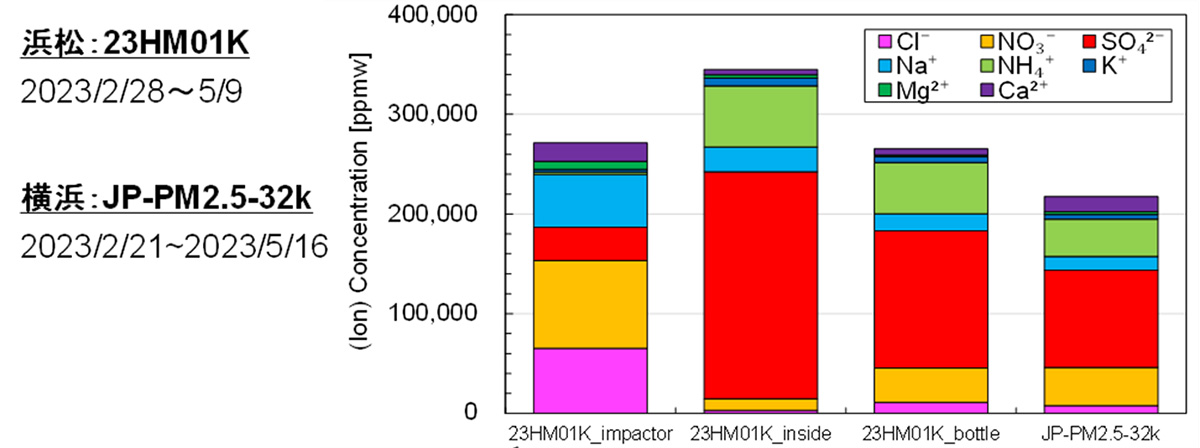試験研究






目的
当財団の定款第4条第1項第(2)号に定める事業の一環として、工業技術の発明考案の実用化の試験研究及び提言事業を実施し我が国の工業技術水準の向上に寄与することを目的とする。
実績
令和5年度共同研究(慶應義塾大学理工学部応用化学科 奥田知明教授との共同研究)
1.研究テーマ
「粒子状物質の有害性評価のための気中粒子操作分析技術の応用」
2.研究の目的
本研究では、慶應大が保有する気中粒子操作分析技術(例えば、バーチャルインパクターやサイクロン、ただしこれらに限らない)を粒子状物質の有害性評価に応用する技術を、天野工技研と共同で開発することを目的として試験研究事業を実施した。
3.今年度の事業内容
大気中PM2.5微粒子の高速回収技術の開発
担当:半田幹人、安間 亘、佐々木春雄、大高祥男、須藤雅夫
1.奥田研サイクロンの移設と実施
- 慶應義塾大学の奥田教授設計の分割型サイクロンを設計し、運転した。
2023年2月28日~5月9日(延べ70日)運転し、奥田先生指導のもと、インパクター上部(91mg)、サイクロン壁面(26mg)、底部容器の3か所(18.6mg)で捕集した。試験的に、インパクター上部の粒子を環境衛生研究所(都田)で、電子顕微鏡分析し、EDX分析を依頼した。
主たる成分は、C炭素であった。又、Na, Clもあり、浜名湖の海水の影響も推察できる。インパクターで捕集した粒子には、花粉らしい突起形状の粒子が見られた。 - 5回の運転を、3か月ごとに実施した。PM2.5粒子は、18mgから50mg捕集した。
2.サイクロン勉強会を7回実施した
- サイクロンの基礎、インパクターの原理、大気中微粒子の観測、集塵の応用、サイクロン内部の流動シミュレーション。「PM2.5微粒子を高速に捕集するための技術」を検討した。12月に、静岡県環境衛生科学研究所(藤枝市)と(株)静岡プラント(吉田町)を見学した。環境衛生研では、実際の分析方法を、静岡プラントでは、ドーム型ミニサイクロンでのデモ実験を見た。
3.2023年の実施結果
- 現在の流量90 L/minを下げずに捕集効率を上げるには、サイクロン内部の流れを制御し、壁面に衝突を繰り返すように流れを作るか、底部容器に落ちるように設計するのがいいのか、捕集効率を実験する。そのために、パーティクルカウンターを購入(40万円)し実験する。また、三次元CAD/CAMシステムを購入(800万円)し、内部の流動を可視化できるようなサイクロンや種々の内部形状の新規なサイクロンを設計した。現在は、3か月で50mgのPM2.5の微粒子を回収しているが、2週間程度に高速化したい。そのために、500 L/min以上の流量が可能で、①サイクロンの大型化、②マルチサイクロン化、③電気集塵機の応用について検討を開始した。
- 浜松のサイクロン装置におけるサイクロン内壁およびビンに捕集された大気粒子の特徴が、 横浜のサイクロン装置内壁に捕集された大気粒子の特徴と類似していた。23HM02Kではいずれもサイクロン内壁の、 インレット直下およびサイクロン下部において採取された粒子の化学的特徴の比較を行った。 水溶性イオン成分分析の結果、いずれの粒子も硫酸イオンを多く含み、これは23HM01K のサイクロン内壁において採取された粒子の化学的特徴と類似しており、比較的微小な粒子の特徴を有していた。
(奥田教授、粒子状物質の有害性評価のための気中粒子操作分析技術の応用より抜粋。詳細は下記の「過去に実施した主要な試験研究と共同研究一覧表に掲載」)

過去に実施した主要な試験研究と共同研究
年次報告書の発行年度別のリストである。実施年度は、1年前である。実施されているが、報告されていない継続研究はのっていない。
| 研究期間(年度) | 試験研究 | 共同研究 |
|---|---|---|
| 1963-1979 | 新しい電子式タクシーメータシステムの開発 | |
| 1987-1990 | 火花点火機関における燃焼ガス温度の測定 | |
| 風向・風速データ統計処理装置の開発 | ||
| 1993-1999 | 電力回生式三相交流誘導電気動力計の開発 | |
| 2003-2009 | 動力計の新しい方式に関する基礎研究 | |
| 2010-2015 | 太陽光発電に於ける発電効率改善の研究 | |
| 2012-2016 | 高出力化が可能な熱電変換の研究 | |
| 2016-2020 | 高速&低温メタン化でCO2の削減と利活用を図る 構造体触媒変換システムの開拓 |
|
| 2019-2020 | 小型木材チップ製造機の調査・開発 | |
| 2022 | 粒子状物質の有害性評価のための大流量開閉式サイクロン装置の開発実用化 | |
| 2023~ | 粒子状物質の有害性評価のための気中粒子操作分析技術の応用 |






